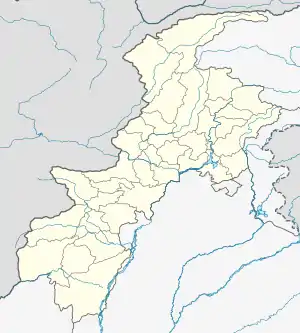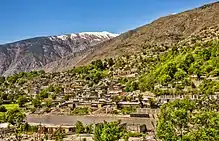Chitral
Chitral (Khowar: ݯھیترار, romanized: ćhitrār, lit. 'field') is a city situated on the Chitral River in northern area of Khyber Pakhtunkhwa. It serves as the capital of the Chitral District and before that as the capital of Chitral princely state, during the British Raj in Colonial India until 1947. The region was encompassed into West Pakistan between the years 1947 and 1972. It has a population of 49,780 per the 2017 census.[7]
Chitral
| |
|---|---|
 Clockwise from top:
| |
| Nickname: Qāshqār | |
 Chitral  Chitral | |
| Coordinates: 35°50′46″N 71°47′09″E | |
| Country | |
| Province | |
| District | Chitral |
| Established | 1885 |
| Founded by | British government |
| Named for | Field |
| Government | |
| • Type | Municipal Corporation |
| • Body | District Government |
| • Mayor | Shahzada Aman-ur-Rehman |
| • MNA | Moulana Abdul Akbar Chitrali[2] |
| • MPA | Hidayat-ur-Rahman[3] |
| • Assistant Commissioner | Adnan Haider Malooki[4] |
| • Deputy Commissioner | Muhammad Ali Khan[5] |
| Area | |
| • Total | 14,850 km2 (5,730 sq mi) |
| Elevation | 1,494 m (4,902 ft) |
| Highest elevation | 1,517 m (4,977 ft) |
| Population (2017)[7] | |
| • Total | 49,780 |
| • Density | 3.4/km2 (8.7/sq mi) |
| Demonym | Chitralis |
| Languages | |
| • Official | Urdu[8] |
| • Regional | Chitrali[8] |
| Time zone | UTC+5:00 (Pakistan Standard Time) |
| Zip Code | |
| Area code | 0943 |
| Vehicle registration | CL |
| Website | lgkp.gov.pk/ |
History
The city was known as Qashqar in ancient times.[11]
Nothing definitive is recorded about the town’s first settlers. In the 3rd century AD, Kanishka, the Buddhist ruler of the Kushan empire, occupied Chitral. In the 4th century AD, the Chinese overran the valley. Raees rule over Chitral began in 1320 and came to an end in the 15th century. From 1571 onwards Chitral was the capital of the princely state of Chitral under the rule of the Katur Dynasty.[12]
Ancient era

The existence of the Gandharan Grave Culture in Chitral,[13] found in various grave sites scattered over its valleys gives an insightful knowledge of its inhabitants following the Indo-Aryan migrations, after the decline of Indus Valley civilization.[14][15] The Gankorineotek cemetery in Singoor is home to several ancient burial sites, dating back to the Vedic period.[16][17][18]
The area which now forms Chitral was reportedly conquered by the Persian Achaemenids and was a part of one of their easternmost satraps.[19] In the third century CE, Kanishka, the Buddhist ruler of the Kushan empire, occupied Chitral. Under the Kushans, many Buddhist monuments were built around the area, mainly Buddhist stupas and monasteries. The Kushans also patronised Buddhist art; some of the finest examples of the image of Buddha were produced in the region under the Kushan rule.[20]
Kator era

From 1571 to 1969, Chitral was the dominion of the Kator Dynasty.[21] The British and Sikh garrison suffered a siege by the Chitralis, possibly aided by Afghan forces, in 1895. The garrison was relieved after six weeks, and the British installed the young Shuja ul-Mulk as Mehtar ("ruler"). He ruled for the next 41 years.[22]
Accession to Pakistan
In 1947, following the division of the British colony of India, princely states were offered the choice to either remain independent or to choose one of the two new dominions. Initially, Chitral chose to remain independent Monarchy. Later, the Mehtar of Chitral, who was a friend of Quaid E Azam Mohammad Ali Jinnah, acceded to Pakistan and thus Chitral became one of the princely states of Pakistan. Through 1969 to 1972, it was fully integrated into Pakistan as the administrative district of Chitral.[23]
Role in the First Kashmir War
Chitral played an instrumental role in the 1947–1948 first Kashmir war. Immediately after acceding to Pakistan, Mehtar Muzaffar ul-Mulk proclaimed Jihad to 'liberate' Kashmir from the Dogras. At this point, the Gilgit scouts were retreating and the Dogra forces had made gains in the Burzil pass. Under these circumstances, the Chitral scouts relieved the Gilgit scouts in Domel and Kamri sectors whilst the Chitral Bodyguard force went towards Skardu. The Chitral bodyguards under the leadership of a Chitral Prince laid one of the longest sieges in military history which ended with the fall of Skardu, the surrender of the Dogras, and the capture of Baltistan. During this time, the Chitral scouts assimilated with the Gilgit scouts and went on towards taking the Kargil pass.[24]
Geography

The city has an average elevation of 1,500 m (4,921 ft).
Climate
In contrast to more southerly valleys of Khyber Pakhtunkhwa, Chitral has a dry Mediterranean climate (Köppen Csa) with almost no rainfall during the very hot summers. Precipitation occurs mainly from spring thunderstorms brought about by western frontal systems. In the winter the night time temperature occasionally drops to −10 C. Winter snowfall in the town can be quite heavy with an accumulation of up to two feet being quite common, at higher elevations snowfall can reach as high as 20 metres (70 ft).
| Climate data for Chitral, Khyber Pakhtunkhwa | |||||||||||||
|---|---|---|---|---|---|---|---|---|---|---|---|---|---|
| Month | Jan | Feb | Mar | Apr | May | Jun | Jul | Aug | Sep | Oct | Nov | Dec | Year |
| Record high °C (°F) | 16.9 (62.4) |
21.0 (69.8) |
28.0 (82.4) |
34.3 (93.7) |
38.3 (100.9) |
42.5 (108.5) |
44.4 (111.9) |
42.2 (108.0) |
39.8 (103.6) |
34.4 (93.9) |
27.0 (80.6) |
20.7 (69.3) |
44.4 (111.9) |
| Average high °C (°F) | 8.8 (47.8) |
9.9 (49.8) |
15.1 (59.2) |
22.5 (72.5) |
28.2 (82.8) |
34.4 (93.9) |
35.9 (96.6) |
34.4 (93.9) |
31.1 (88.0) |
25.1 (77.2) |
18.7 (65.7) |
11.6 (52.9) |
23.0 (73.4) |
| Daily mean °C (°F) | 4.1 (39.4) |
5.3 (41.5) |
9.6 (49.3) |
15.5 (59.9) |
20.3 (68.5) |
26.1 (79.0) |
28.0 (82.4) |
26.5 (79.7) |
22.1 (71.8) |
16.2 (61.2) |
10.8 (51.4) |
5.9 (42.6) |
15.9 (60.6) |
| Average low °C (°F) | −0.6 (30.9) |
0.6 (33.1) |
4.2 (39.6) |
8.5 (47.3) |
12.5 (54.5) |
17.8 (64.0) |
20.2 (68.4) |
18.7 (65.7) |
13.1 (55.6) |
7.2 (45.0) |
2.9 (37.2) |
0.2 (32.4) |
8.8 (47.8) |
| Record low °C (°F) | −11.0 (12.2) |
−11.0 (12.2) |
−3.7 (25.3) |
0.0 (32.0) |
4.4 (39.9) |
8.9 (48.0) |
11.1 (52.0) |
10.6 (51.1) |
5.6 (42.1) |
1.1 (34.0) |
−3.0 (26.6) |
−12.2 (10.0) |
−12.2 (10.0) |
| Average precipitation mm (inches) | 38.4 (1.51) |
63.8 (2.51) |
97.3 (3.83) |
71.7 (2.82) |
43.9 (1.73) |
5.1 (0.20) |
4.9 (0.19) |
8.0 (0.31) |
7.3 (0.29) |
15.6 (0.61) |
20.4 (0.80) |
38.5 (1.52) |
414.9 (16.32) |
| Mean monthly sunshine hours | 134.0 | 133.7 | 150.4 | 188.6 | 247.0 | 286.3 | 285.4 | 258.6 | 231.0 | 214.0 | 182.5 | 130.7 | 2,442.2 |
| Source: NOAA (1971-1990) [25] | |||||||||||||
Demographics
Urdu is the official language of the city.[8] According to the 1981 census, Khowar is the main language and is spoken by 90% of the population. Pashto is also spoken by a small population.[26]
As per the 2017 census, Chitral has a population of 49,780.[7]
Educational institutions
Notable people
See also
References
- "District Chitral (Upper & Lower)". Department of Local Government, Government of Khyber Pakhtunkhwa. Retrieved 18 January 2022.
- "National Assembly of Pakistan".
- "Hidayat ur Rahman | KP Assembly". www.pakp.gov.pk. Retrieved 27 September 2023.
- "Man arrested for selling 'spurious' drugs". Chitral Today. 16 December 2022. Retrieved 26 September 2023.
- "Deputy Commissioner assures normalcy in Chitral". 8 September 2023.
- Ahmada, Munir; Muhammadb, Dost; Mussaratb, Maria; Naseerc, Muhammad; Khand, Muhammad A.; Khanb, Abid A.; Shafi, Muhammad Izhar (2018). "Spatial variability pattern and mapping of selected soil properties in hilly areas of Hindukush range northern, Pakistan". Eurasian Journal of Soil Science. 7 (4): 355. doi:10.18393/ejss.466424. Retrieved 29 August 2019 – via dergipark.org.tr.
- "Khyber Pakhtūnkhwā / North-West Frontier (Pakistan): Province, Major Cities, Municipalites & Towns - Population Statistics, Maps, Charts, Weather and Web Information". Citypopulation.de. Retrieved 30 May 2022.
- "Indo-Iranian Frontier Languages". Encyclopaedia Iranica. 15 November 2006. Retrieved 6 November 2015.
- Postal code
- "List of Postal Codes of GPOs of Chitral Pakistan Post 2023".
- https://www.britannica.com/place/Chitral
- "Chitral, a Study in Statecraft" (PDF). IUCN.
- Ali, Ihsan; Batt, Cathy; Coningham, Robin; Young, Ruth (1 September 2002). "New exploration in the Chitral Valley, Pakistan: an extension of the Gandharan Grave culture". Antiquity. 76 (293): 647–654. doi:10.1017/S0003598X00091055. S2CID 53462554. Retrieved 11 March 2023 – via go.gale.com.
- Schug, Gwen Robbins; Walimbe, Subhash R. (13 April 2016). A Companion to South Asia in the Past. John Wiley & Sons. ISBN 978-1-119-05547-1.
- "Mera Chitral: History of chitral". Mera Chitral. Retrieved 1 February 2020.
- "3 Child burial at Gankorineotek cemetery, Chitral, excavated in 2007-2008". Retrieved 11 March 2023.
- Hemphill, Brian E.; Zahir, Muhammad; Ali, Ihsan (29 December 2017). "Skeletal Analysis of Gandharan Graves at Shah Mirandeh, Singoor, Chitral".
- "Scientists say discovery of 3,000-year-old burial site key to tracing origins of Pakistan's Chitral". Arab News PK. 15 October 2021. Retrieved 3 December 2022.
- Notes on Chitral. L.D. Scott. 1903.
- Gurdon's Report on Chitral. Gurdon. 1903.
- "Chitral, a Study in Statecraft" (PDF). IUCN. Retrieved 6 November 2015.
- Holdich, Thomas Hungerford (1911). . In Chisholm, Hugh (ed.). Encyclopædia Britannica. Vol. 6 (11th ed.). Cambridge University Press. pp. 251–252.
- Osella, Filippo; Soares, Benjamin (2010). Islam, Politics, Anthropology. John Wiley & Sons. p. 58. ISBN 978-1-4443-2441-9.
- "Full text of "An Illustrated History of Chitral Scouts 1900-2015"". archive.org. Retrieved 2 February 2020.
- "Chitral Climate Normals 1971-1990". National Oceanic and Atmospheric Administration. Retrieved 16 January 2013.
- "Population Demography". Kpktribune.com. Archived from the original on 28 December 2017. Retrieved 18 November 2017.
Bibliography
- Decker, D. Kendall (1992). Languages of Chitral. Ishi Press International. ISBN 4871875202.
- Durand, Col. A. (1899). The Making of a frontier.
- Leitner, G. W. (1893). Dardistan in 1866, 1886 and 1893: Being An Account of the History, Religions, Customs, Legends, Fables and Songs of Gilgit, Chilas, Kandia (Gabrial) Yasin, Chitral, Hunza, Nagyr and other parts of the Hindukush, as also a supplement to the second edition of The Hunza and Nagyr Handbook. And An Epitome of Part III of the author's The Languages and Races of Dardistan (First reprint ed.). New Delhi: Manjusri Publishing House. ISBN 4871877787.
Further reading
- Allan, Nigel J. R.; Buddruss, Georg (1991). "CHITRAL". Encyclopaedia Iranica, Vol. V, Fasc. 5. pp. 487–494.
External links
- Official website
- Government of Khyber-Pakhtunkhwa
- Khyber-Pakhtunkhwa Government website section on Lower Dir
- United Nations